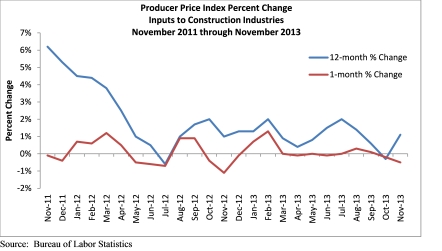Overall, construction materials prices fell 0.5 percent in November and are up only 1.1 percent year over year, according to the Department of Labor’s Dec. 13 Producer Price Index. Nonresidential construction materials are down 0.6 percent for the month and are 0.7 percent lower than the same time last year.
“November represented another month of remarkable stability for construction input prices,” said Associated Builders and Contractors (ABC) Chief Economist Anirban Basu. “Although many investors predicted significant inflation this year due to expansionary monetary policies in much of the developed world, there continues to be a lack of significant inflationary pressures both globally and nationally.”
Overall, the nation’s wholesale goods prices expanded 0.2 percent in November, but are down 0.9 percent year over year.
“Next year is unlikely to offer as much stability as 2013,” Basu said. “Global economic growth is set to accelerate and the apparent budget deal in Congress should produce greater certainty among businesses, helping improve an already benign national economic forecast. Tension in the Middle East also continues to be a consideration. Together, these factors suggest materials price increases may be at least slightly more rapid in 2014.”
THE FOLLOWING MATERIALS PRICES INCREASED IN NOVEMBER:
- Fabricated structural metal products were up 0.1 percent for the month and 0.3 percent year over year.
- Softwood lumber prices increased 2.6 percent on a monthly basis and are up 12.8 percent year over year.
- Natural gas prices were up 1.9 percent for the month and 3.3 percent on an annual basis.
- Nonferrous wire and cable prices rose 0.2 percent on a monthly basis and are down 3 percent year over year.
- Iron and steel prices were up 1.8 percent for the month and are down 0.1 percent compared to the same time last year.
- Prices for plumbing fixtures and fittings inched up 0.1 percent in November and are up 1.6 percent year over year.
- Steel mill products prices increased 0.8 percent in November but are down 0.6 percent compared to the same time last year.
THE FOLLOWING CONSTRUCTION INPUTS EXPERIENCED PRICE DECREASES IN NOVEMBER:
- Prepared asphalt, tar roofing and siding prices were down 3.8 percent for the month and 0.3 percent year over year.
- Crude petroleum prices fell 10.3 percent on a monthly basis but are up 0.9 percent year over year.
- Crude energy prices decreased 5.7 percent in November but are up 0.6 percent compared to the same time last year.
- Concrete products prices were flat in November and are up 2.8 percent year over year.
Related Stories
Construction Costs | Feb 27, 2024
Experts see construction material prices stabilizing in 2024
Gordian’s Q1 2024 Quarterly Construction Cost Insights Report brings good news: Although there are some materials whose prices have continued to show volatility, costs at a macro level are returning to a level of stability, suggesting predictable historical price escalation factors.
High-rise Construction | Feb 23, 2024
Designing a new frontier in Seattle’s urban core
Graphite Design Group shares the design for Frontier, a 540,000-sf tower in a five-block master plan for Seattle-based tech leader Amazon.
Construction Costs | Feb 22, 2024
K-12 school construction costs for 2024
Data from Gordian breaks down the average cost per square foot for four different types of K-12 school buildings (elementary schools, junior high schools, high schools, and vocational schools) across 10 U.S. cities.
MFPRO+ Special Reports | Feb 22, 2024
Crystal Lagoons: A deep dive into real estate's most extreme guest amenity
These year-round, manmade, crystal clear blue lagoons offer a groundbreaking technology with immense potential to redefine the concept of water amenities. However, navigating regulatory challenges and ensuring long-term sustainability are crucial to success with Crystal Lagoons.
Architects | Feb 21, 2024
Architecture Billings Index remains in 'declining billings' state in January 2024
Architecture firm billings remained soft entering into 2024, with an AIA/Deltek Architecture Billings Index (ABI) score of 46.2 in January. Any score below 50.0 indicates decreasing business conditions.
University Buildings | Feb 21, 2024
University design to help meet the demand for health professionals
Virginia Commonwealth University is a Page client, and the Dean of the College of Health Professions took time to talk about a pressing healthcare industry need that schools—and architects—can help address.
AEC Tech | Feb 20, 2024
AI for construction: What kind of tool can artificial intelligence become for AEC teams?
Avoiding the hype and gathering good data are half the battle toward making artificial intelligence tools useful for performing design, operational, and jobsite tasks.
Engineers | Feb 20, 2024
An engineering firm traces its DEI journey
Top-to-bottom buy-in has been a key factor in SSOE Group’s efforts to become more diverse, equitable, and inclusive in its hiring, mentoring, and benefits.
Building Tech | Feb 20, 2024
Construction method featuring LEGO-like bricks wins global innovation award
A new construction method featuring LEGO-like bricks made from a renewable composite material took first place for building innovations at the 2024 JEC Composites Innovation Awards in Paris, France.
Codes and Standards | Feb 20, 2024
AISC, AIA release second part of design assist guidelines for the structural steel industry
The American Institute of Steel Construction and AIA Contract Documents have released the second part of a document intended to provide guidance for three common collaboration strategies.


















